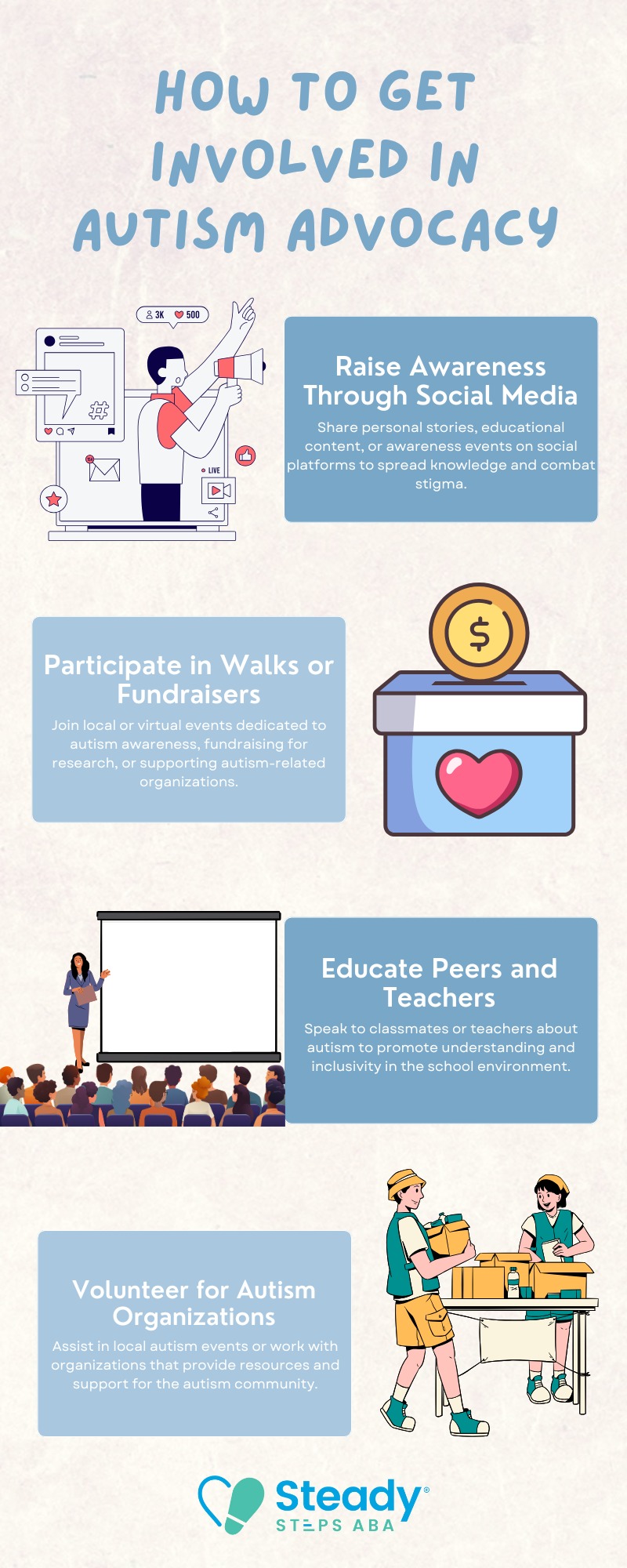Key Points:
- Learning how to advocate for autism begins with listening to autistic voices and understanding real-world challenges.
- Advocacy can happen at home, in schools, and in public policy—each setting offers an opportunity to promote inclusion.
- Parents, caregivers, and allies can start today with small, effective steps that build awareness and support meaningful change.
Autism affects approximately 1 in 31 children in the United States, and as awareness grows, so does the need for advocacy. However, it’s important to remember that being aware isn’t the same as understanding.
That’s where advocacy comes in—it bridges the gap between awareness and action. To truly support those on the autism spectrum, families, caregivers, educators, and community members must learn to advocate for autism in meaningful and informed ways.
Advocating for autism isn’t about speaking for autistic people but rather amplifying their voices and ensuring they are heard and respected. Whether you’re a parent of a newly diagnosed child, an educator, or simply someone who wants to make a difference, there are practical ways to begin your advocacy journey today.
How Do You Advocate for Autism?
To advocate for autism effectively, start by educating yourself, supporting inclusion, and speaking up against misinformation. Advocacy involves listening to autistic individuals, promoting their rights, and helping shape more inclusive communities. You don’t need to be an expert to make a difference—what matters most is empathy, consistency, and action.
Advocating can also mean working within schools, workplaces, or public spaces to ensure that policies and practices are inclusive and accommodating. This includes pushing for sensory-friendly environments, accessible communication options, and equitable opportunities in education and employment.
What are the First Steps to Advocate for Autism?
Advocacy might sound like a big commitment, but getting started can be as simple as changing your daily conversations. Before marching in rallies or contacting lawmakers, it’s important to build a strong foundation of understanding. Advocacy begins with listening and learning.
Let’s explore some practical first steps to help you become an informed and effective autism advocate:
1. Educate Yourself About Autism
Start by reading books and articles written by autistic authors to gain insights from lived experiences. Staying updated with current research and clinical best practices can help deepen your understanding of autism and how it presents in different individuals.
It’s also important to recognize that autism is a spectrum—no two autistic people are exactly alike, and their needs and strengths can vary widely.
2. Listen to Autistic Voices
Follow autistic self-advocates on social media to hear their perspectives directly. You can also join forums or attend local events and panels where autistic individuals share their stories. It’s essential to listen without speaking over them or making assumptions about their experiences—true advocacy means respecting and elevating their voices.
3. Challenge Stereotypes and Misinformation
Be proactive in correcting common misconceptions, such as the belief that all autistic people are the same or lack empathy. Speak up when you hear dismissive or harmful comments about autism, whether in casual conversations or public discussions. Promote acceptance and neurodiversity by encouraging open-minded, respectful dialogue in your community.
Where Can You Make the Most Impact as an Autism Advocate?
Advocacy isn’t limited to public rallies or formal events—it often starts in everyday settings like your home, school, or community. Knowing where and how to focus your efforts can make your advocacy more effective and sustainable.
Here’s how you can make the most impact as an autism advocate:
1. At Home
Home is where understanding and acceptance begin. Model respect, empathy, and patience in how you talk about and interact with autism. Use respectful language and avoid negative labels when discussing your child’s behavior or diagnosis.
Take time to educate siblings and extended family members so they can offer informed and compassionate support. Most importantly, celebrate your child’s unique strengths, talents, and interests to build their confidence and self-worth.
2. In Schools
Schools are vital spaces where autistic children face both challenges and opportunities. Advocacy here can have a direct impact on their academic and social development. Work closely with teachers and staff to develop or revise an Individualized Education Program (IEP) that reflects your child’s needs.
Advocate for inclusive classroom settings and support anti-bullying policies that protect neurodivergent students. You can also help by organizing autism awareness activities or promoting sensitivity training for educators and peers.
3. In the Community
Your voice can help shape a more autism-friendly community. Encourage local businesses to adopt sensory-inclusive practices, such as quiet hours or visual supports. Support or organize community events that promote neurodiversity and inclusion, creating opportunities for autistic individuals to engage and thrive.
Volunteering with or donating to autism-focused organizations is another meaningful way to contribute to broader change—just as creating inclusive job opportunities empowers individuals on the spectrum to thrive, as explored in Unlocking Potential Through Employment for Autistic People.

What are Effective Advocacy Strategies for Parents of Autistic Children?
Parents often become natural advocates for their children, but advocacy can be emotionally taxing without a clear strategy. Staying organized, informed, and connected can empower you and help prevent burnout.
Below are essential strategies that parents can use to advocate for their autistic children in everyday life:
1. Document Everything
Keep a binder or digital folder with school reports, medical records, and therapy notes. Tracking your child’s progress, behaviors, and treatment responses helps you communicate clearly with professionals. Having documentation ready also strengthens your position during meetings or disputes.
2. Build a Support Network
Connect with other parents through local groups or online communities. Sharing resources, experiences, and advice can offer emotional support and practical tips. A strong network also helps you stay informed and feel less alone in your advocacy journey.
3. Communicate Proactively
Regularly check in with teachers, therapists, or support staff. Address concerns early to avoid escalation and focus discussions on finding solutions. Clear, goal-oriented communication builds stronger partnerships with those involved in your child’s care.
4. Stay Calm and Persistent
Advocating for your child can be challenging, especially when facing delays or resistance. Stay respectful but firm, and keep written records of all interactions. Persistence, paired with preparation, ensures your child’s needs stay a priority.
How to Advocate for Autism Through Public Policy
Beyond day-to-day efforts, advocating for systemic change can lead to long-term benefits for the autism community. Public policy efforts help shape laws and funding that support education, healthcare, and disability rights.
You don’t need to be a lobbyist to get involved. These are actionable ways to help shift policies in favor of autistic individuals:
1. Contact Your Representatives
Reach out to your state and federal lawmakers to share your concerns and support for autism-related legislation. Personal stories can be powerful—showing how policies impact real families makes your message more meaningful and memorable.
2. Stay Informed About Policy Changes
Follow trusted disability rights organizations to keep up with legal updates. Supporting bills that expand funding for therapy, education, and accommodations ensures better services and opportunities for autistic individuals.
3. Participate in Advocacy Days
Join events like Autism Advocacy Day at your state capitol. These gatherings help raise awareness, build community, and give families the chance to speak directly with decision-makers about what matters most.
4. Sign Petitions or Public Letters
Lend your voice to coordinated campaigns by signing petitions or open letters. These efforts can influence schools, businesses, or lawmakers to adopt more inclusive practices and policies.
How Can Kids and Teens Get Involved in Autism Advocacy?
Autism advocacy is an empowering way for children and teens on the spectrum to raise awareness, share their experiences, and help others understand autism better. Getting involved in advocacy not only fosters a sense of empowerment but also helps build connections with others in the community.
Whether through personal experiences or broader awareness campaigns, kids and teens can contribute in meaningful ways to create more inclusive environments for everyone. Below are several ways young people can take part in autism advocacy:

Why ABA Therapy Supports the Advocacy Journey
Autism advocacy isn’t just about awareness—it’s about action. Applied Behavior Analysis (ABA) therapy gives children with autism tools to build confidence, navigate social challenges, and develop essential life skills. For families looking to support their child in a comprehensive and individualized way, ABA can be a powerful step forward.
At Steady Steps ABA, we provide personalized ABA therapy in Maryland, designed to meet your child’s unique needs. Our team works hand-in-hand with families to support social, behavioral, and academic growth. Whether your child is learning to communicate, manage emotions, or adapt to new environments, ABA can help turn everyday challenges into opportunities for success.
Contact us today to learn more about ABA therapy in Maryland—and how we can support your family’s advocacy efforts today. Together, we can build a more inclusive and empowering world for individuals with autism.



